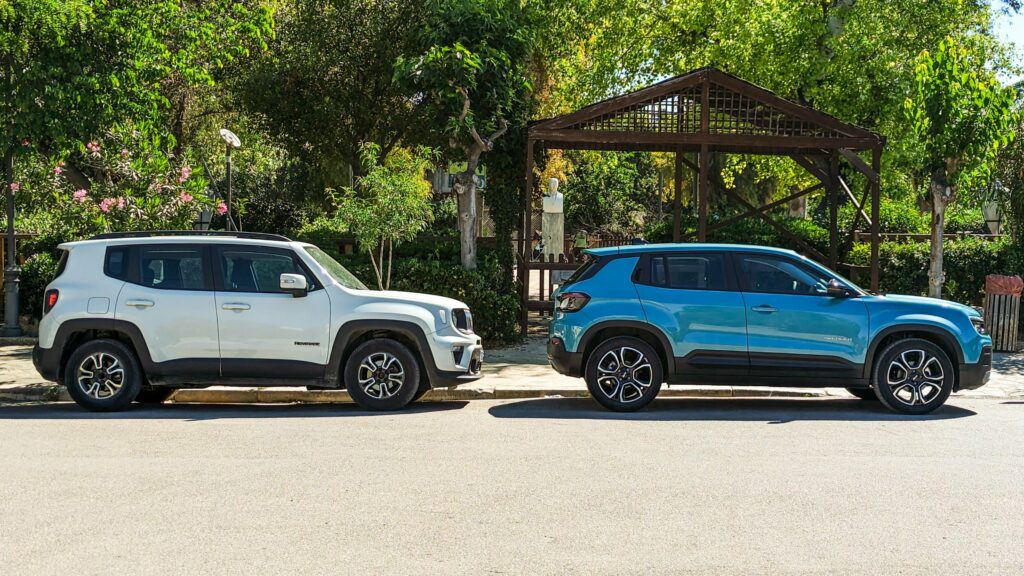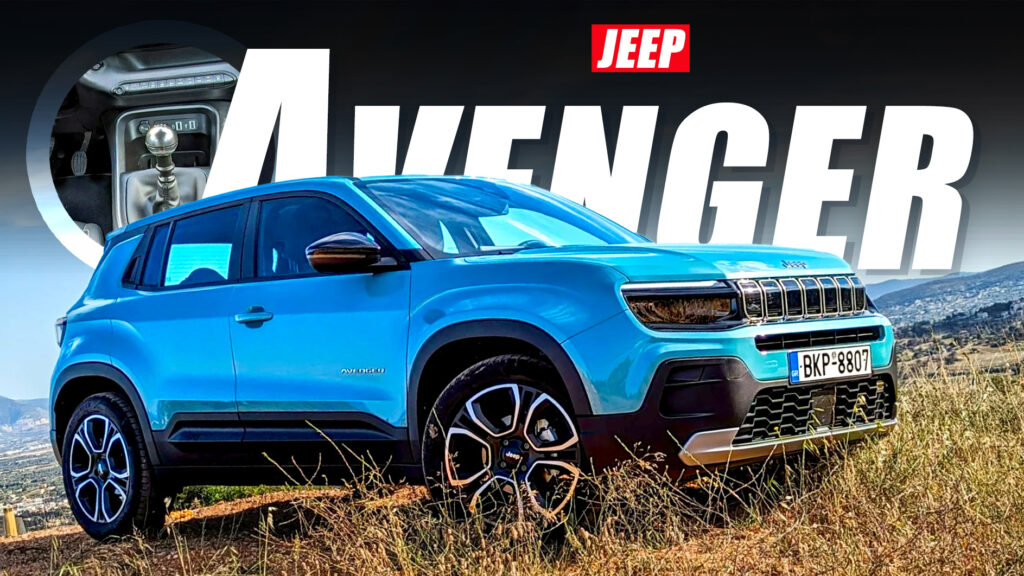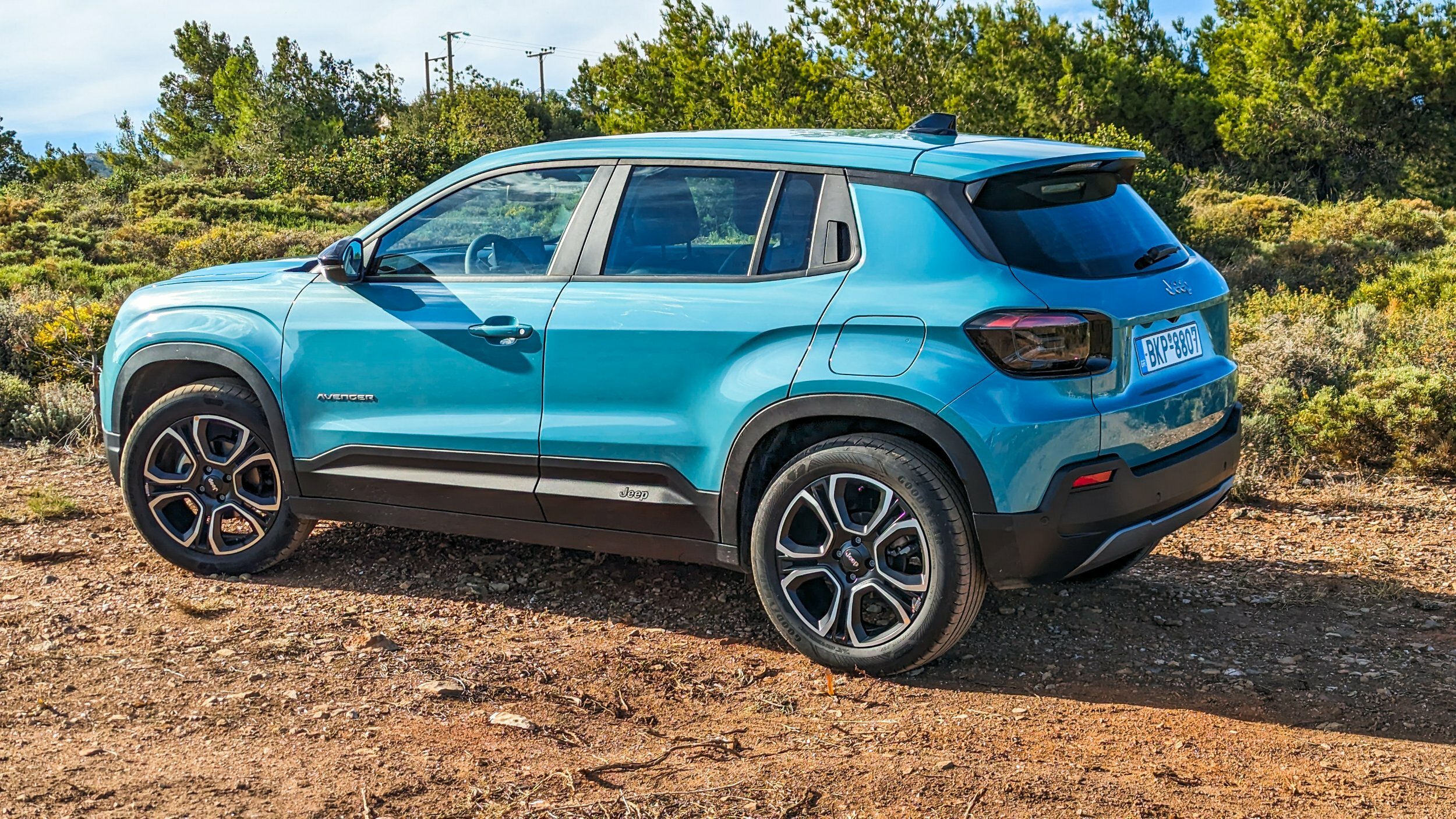While the Jeep Avenger debuted in 2022 as the brand’s first electric vehicle, its lineup swiftly expanded to include internal combustion engine (ICE) and mild-hybrid options. Having experienced the EV, we recently jumped behind the wheel of the base Avenger equipped with the non-electric 1.2-liter gasoline engine and a manual transmission to see how this setup fits with the urban SUV lifestyle.
Modern Styling And Functional Interior
The Avenger cuts a stylish figure as a subcompact SUV. Its muscular body and athletic proportions are accentuated by a modern yet simplistic interpretation of Jeep’s design language. While entry-level models with small wheels and halogen headlights might appear somewhat basic, our press car’s vibrant Lake Green paint and 18-inch wheels definitely add a touch of undeniable charm.
Review: Jeep Avenger EV Is A Fun Little Gem That’s Too Small For US
The gas-powered Avenger can be visually distinguished from its electric counterpart in a few subtle ways. The most noticeable (and obvious) difference is the presence of a tailpipe at the rear. This exhaust emerges from a cutout in the aluminum-style skid plate and features a rather large, trapezoidal design. Additionally, the gas-powered model omits the “e” badge on the taillight and retains a mostly blocked seven-slot grille for improved aerodynamics.
Quick Facts
The Avenger’s interior prioritizes practicality over plushness. While hard plastics dominate most surfaces, they’re well-assembled and shrug off everyday wear. The focus here is on functionality, and the technology feels modern. The standard 10.25-inch infotainment touchscreen is responsive and offers wireless connectivity, a must-have feature these days.
However, the digital instrument cluster, also measuring 10.25 inches, could benefit from more customization options to truly elevate the driving experience.
At 4,084 millimeters (160.8 inches) long, the Avenger positions itself as a conveniently sized sub-compact SUV. It slips in 146 millimeters (5.7 inches) shorter than the Renegade and a full 336 millimeters (13.2 inches) shorter than the Compass. Despite its subcompact footprint, the Avenger’s boxy design and clever interior packaging create will seat four adults in relative comfort for shorter trips, while the 380-liter (13.4 cubic feet) cargo area provides ample storage for everyday essentials.
Thanos Pappas for CarScoops
In-cabin storage is ample, though the manual gearbox necessitated the removal of the large center console compartment typical in EVs. Instead, it features a smaller wireless charging cubby beneath the dual USB ports.
Back-To-Basics Configuration
Initially, Jeep restricted the availability of the ICE-powered Avenger to specific European markets, confident in the dominance of EVs. However, the global slowdown in EV adoption prompted the company to reconsider, now placing greater emphasis on ICE and mild-hybrid powertrain options.
The turbocharged 1.2-liter three-cylinder engine powering our Avenger is a stalwart across various Stellantis brands (Fiat, Citroen, DS, Opel, and Peugeot) for their subcompact and compact models. In its latest iteration, it delivers 99 hp (74 kW / 100 PS) and 205 Nm (151.2 lb-ft) of torque, slightly less than the EV by 55 hp (41 kW / 56 PS) and 55 Nm (41 lb-ft).
The non-electrified powertrain is exclusively combined with a six-speed manual gearbox, as the six-speed dual-clutch automatic is reserved for the mild-hybrid. As with all versions of the Jeep Avenger with the sole exception of the flagship mild-hybrid 4xe, power is transmitted to the front wheels.
Despite its modest horsepower, the engine proved capable of propelling the Avenger’s compact frame, particularly effective in the mid-range. Weighing in at 1,182 kg (2,606 lbs), the ICE version is 354 kg lighter than its battery electric counterpart. While acceleration may not deliver thrills, it’s sufficient for everyday driving, bolstered by the well-tuned manual gearbox and decent torque output.
At higher RPMs, the powertrain lacks grunt and can become noisy, unlike in larger Stellantis vehicles equipped with the same motor and better insulation. Nevertheless, as long as you don’t push it to its limits, the gas-powered Avenger performs adequately as a cruiser for its size, boasting a notably higher top speed compared to its electric counterpart.
Photos Thanos Pappas for CarScoops
When pushed, the small engine can prove particularly thirsty, making the factory consumption ratings feel utopian. Based on our experience, the average fuel consumption in mixed conditions typically ranges between 7.5 to 8.0 lt/100 km (29-31 mpg), unless the driver has a light right foot and is armed with patience.
Another highlight of the ICE-powered Avenger is its 580 km (360 miles) range with a full tank of gasoline, significantly surpassing the charger-dependent EV’s WLTP figure of 400 km (248 miles).
The Jeep-specific suspension setup remains one of the Avenger’s greatest strengths, providing a refined and comfortable ride for the standards of the segment. At the same time, the little Jeep has great handling, with plenty of traction and not much body roll when you throw it at corners. Brakes are slightly smaller in diameter compared to the heavier EV but do a great job in stopping the lighter gas-guzzling Avenger with ease..
Despite its front-wheel-drive (FWD) layout, the Avenger demonstrates decent capability on uneven terrain. The 201 mm (7.9 inches) of ground clearance and short overhangs provide good approach and departure angles, inspiring driver confidence.
While the FWD system might be a limitation for serious off-roading, the standard Selec-Terrain drive modes (Eco, Normal, Sport, Sand, Mud, Snow) offer some mitigation. These modes adjust electronic settings to optimize traction in slippery conditions. However, they don’t have as dramatic an effect on driving dynamics as they do in the electric Avenger, where they significantly alter powertrain output.
More: Jeep Avenger Finally Gets An AWD Upgrade And Off-Road Chops
The bottom line is that the Avenger might be more adventurous than most of the rival subcompact SUVs, but those who intend to take it off the beaten track on a regular basis should probably aim for the AWD-capable mild-hybrid 4xe, which also rides on a more suitable set of tires.
Pricing and Equipment
In Greece, where we tested it, the Jeep Avenger 1.2 starts from €24,267 (equal to $26,346) in Longitude form, and from €26,267 ($28,517) in the better-equipped Altitude. This makes it €2,500 ($2,714) cheaper than the equivalent mild-hybrid and a full €14,710 ($15,970) more affordable than the EV before any government subsidies are applied.
The entry-level Longitude model offers halogen headlights and 16-inch wheels, complemented by standard features such as a 10.1-inch infotainment system, six-speaker audio setup, and rear parking sensors. Stepping up to the mid-spec Altitude model adds enhancements like 17-inch wheels, a 10-inch digital instrument cluster, and adaptive cruise control.

The stylish 18-inch wheels come as part of a €1,893 ($2,055) package, which also includes the X-shaped full-LED taillight graphics and interior ambient lighting. Additionally, there’s an optional package priced at €1,559 ($1,693) that bundles features like a hands-free tailgate, wireless charging pad, built-in navigation, and JBL audio system.
Most of the above features come standard in the flagship Summit trim, which is only available for the electric Avenger in this market.
Verdict
The ICE-powered Jeep Avenger retains the cool factor of its EV counterpart, boasting the added convenience of refueling and a notably lower starting price. Its turbocharged 1.2-liter engine delivers ample power for most needs, complemented by the well-tuned six-speed manual gearbox, though it can get noisy and thirsty under hard acceleration.
Thanks to its Jeep-specific chassis tuning, the Avenger offers a surprisingly refined ride for its segment, while the cabin is roomier than expected for a 4,084 mm (160.8 inches) long SUV.
While the ICE package offers compelling value, those with a slightly more flexible budget are likely to opt for the more technically-advanced mild-hybrid variant of the same engine. This option promises fuel savings and introduces the convenience of an automatic gearbox without breaking the bank. Finally, the mild-hybrid Jeep Avenger 4Xe with AWD capability sounds like the most desirable version of the model, but we expect it to be significantly more expensive.











































































